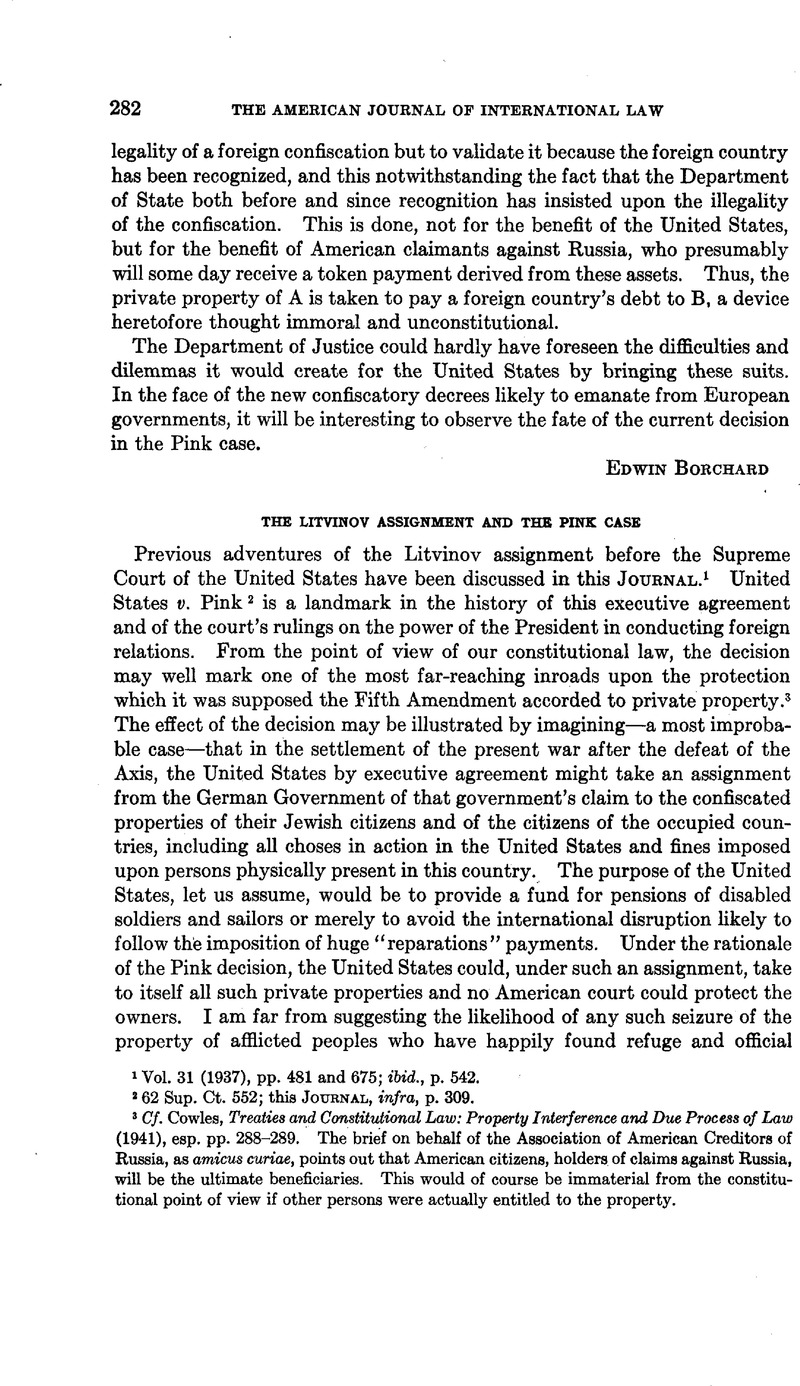Published online by Cambridge University Press: 12 April 2017

1 Vol. 31 (1937), pp. 481 and 675; ibid., p. 542.Google Scholar
2 62 Sup. Ct. 552; this Journal, infra, p. 309.
3 Cf. Cowles, Treaties and Constitutional Law: Property Interference and Due Process of Law (1941), esp. pp. 288–289. The brief on behalf of the Association of American Creditors of Russia, as amicus curiae, points out that American citizens, holders of claims against Russia, will be the ultimate beneficiaries. This would of course be immaterial from the constitutional point of view if other persons were actually entitled to the property.
4 Many of the cases are summarized in Report of the Committee on International Law, New York State Bar Association, Jan. 1942, p. 7 ff., and see XLI Col. Law Rev. (1941), 1039 and 1072. For suggestions of limits beyond which sympathy has not carried the courts, see Arnstein v. Compagnie Generate Transatlantique (1941), 31 N. Y. Supp. (2d) 524; Branderbit v. Hamburg-American Line (1941), ibid., 588.
5 (1939) 280 N. Y. 286.
6 Brief on Behalf of the Association of American Creditors of Russia, as amicus curiae, in the Pink case.
7 Annual Report of the Attorney General of the United States, 1938, p. 123.Google Scholar
8 This Journal, Vol. 31 (1937), p. 482.Google ScholarPubMed
9 But see Leflar, “ Extrastate Enforcement of Penal and Governmental Claims,” 46 Harvard Law Review (1932), p. 193.Google Scholar
9a On this point see the decision of the Appellate Division of the New York Supreme Court in Bollack v. Société Générale pour Favoriser le Développement du Commerce et de l’lndustrie en France, March 27, 1942, New York Times, March 28, 1942. The court remarked by Townley, J., in sustaining the argument that it Was against the public policy of New York to enforce a decree of the Vichy Government which expatriated the plaintiff and confiscated his property: “The only cases whichhave given validity to confiscatory decrees are cases arising under the Litvinov assignment. . . . The effect of these decisions [Belmont, Pink and Manhattan Co. cases] is that the Litvinov assignment and the title acquired thereunder must be given effect regardless of any local public policy to the contrary.”
10 Department of State Bulletin (Vol. VI, p. 146, Feb. 7, 1942 Google Scholar) summarizes the decision in the Pink case under the caption, “Supremacy of Federal Policy over State Policy in Matter of Recognition of Foreign Government.” Cf. the excellent note “Foreign Funds Control Through Presidential Freezing Orders,” in XLI Col. Law Rev. (1941), 1039, at 1056 and note 101; also “Protective Expropriatory Decrees of the Governments in Exile–Their Application in the United States,” ibid., 1072, at 1087, note 104. See also “ TheDoctrine of the Erie Railroad v. Tompkins Applied to International Law,” this JOURNAL,Vol.33 (1939), p. 740.Google ScholarPubMed
11 See Hudson, “The Treaty-Making Power of the United States in Connection with the Manufacture of Arms and Ammunition,” this Journal, Vol. 28 (1934), p. 736.Google ScholarPubMed
12 Cf. Domke, “International Aspects of European Expropriation Measures,” 22 Proceedings American Foreign Law Association (1941), and last footnote, supra.Google Scholar
13 See Anderson v. N. V. Transandine Handelmaatschappij et al., 28 N. Y. Supp. (2d)547; aff'd. N. Y. L. J., Nov. 15, 1941, p. 1513.
14 Amstelbank, N. V. v. Guaranty Trust Co. (1941), 31 N. Y. Supp. (2d), 194, 199. To the same effect, see Koninklijke Lederfabriek “Oisterwijk,” N. V. v. Chase National Bank,177 Misc. 186; aff’d. N. Y. L. J., Dec. 20, 1941, p. 2070.
15 See Williamson Act, N. Y. Laws, 1941, c. 150; also amendments to Sees. 474, 978 of N. Y. ,C. P. A. (June 2, 1939); amendment to Sec. 269 of the N. Y. Surr. Ct. Act (April 24,1939).
16 The Dutch decree of May 24, 1940 is printed in C. C. H., War Law Service, Foreign Supplement, § 67, 154 (1941).
17 Supra, note 13. To the same effect, see Gruenbaum v. N. V. “Oxyde” Maatschappij voor Ersten en Metalen, N. Y. L. J., Aug. 27, 1941, p. 439; Duesterwald v. Ladewig, ibid.,Jan. 15, 1942, p. 215.
18 King’s Bench Division, Dec. 19, 1941, not yet reported.
19 Apparently the same Norwegian decree was also given extraterritorial effect by the Supreme Court of Gothenburg, Sweden, in March, 1942. The suit was for the possession of ten Norwegian ships in Swedish waters, which had been taken over by the Norwegian Government in London and chartered to the British Government. The original Norwegian owners, still resident in German-occupied Norway, sought to oust the British officers and crews and to obtain possession. In rejecting their claims, the Swedish Supreme Court seems to have relied in part upon the defense of sovereign immunity which apparently was raised by the British Government; the full text of the decision is not yet available. See American Swedish News Exchange, Inc., Release No. 32, Oct. 29, 1941; Release No. 52, March 18. 1942; Release No. 53, March 25, 1942